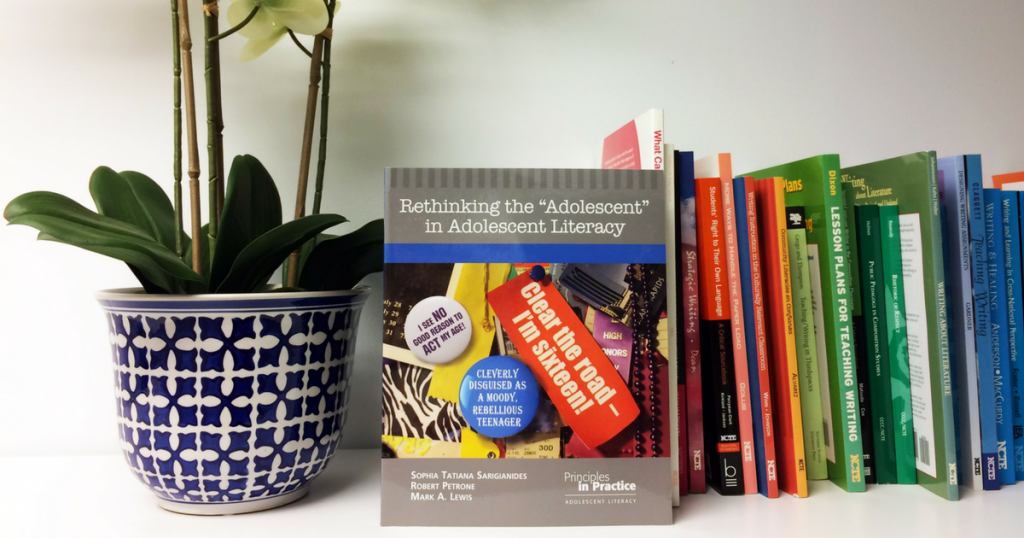This post was written by members Sophia Tatiana Sarigianides, Robert Petrone and Mark A. Lewis.
As the popularity of young adult books and films based on them continues to explode around the world, so too do ideas on how to teach these books within English classrooms. This attention to Young Adult Literature (YAL) has also drawn quite a lot of attention to young adults—both to young adults themselves, and to our cultural ideas and beliefs about concepts such as youth, adolescence, and adulthood. Regularly, stories and studies emerge on new stages of life (e.g., “Emerging Adults: The In-between Age”), as well as scientific evidence explaining how and why teenagers act the ways they do (i.e., , the “teenage brain”.) Needless to say, it’s an exciting and critical time to be in a profession that is at the front lines of working with and on behalf of youth.
Over the past few years, the three of us, as English teacher educators and researchers, have developed a line of scholarship that centers on representations of adolescence as they relate to teaching secondary students. Specifically, we argue that a reexamination of our ideas about youth offers myriad possibilities for opening up the literacy curriculum to make it more pertinent, social-justice oriented, and stimulating for our students. After sharing these ideas in various journals, including a special-themed issue of NCTE’s English Journal, which collected a range of other educators engaged in similar work, our efforts have now culminated in a book for NCTE’s Principles in Practice series, Re-thinking the “Adolescent” in Adolescent Literacy.
Our primary goal in this book is to challenge English teachers’ ideas of youth. To this aim, the book opens with an explanation of the central assumptions supporting the classroom- and curriculum-based chapters that follow: namely, that our normative cultural ideas of adolescence are not “natural,” but rather have been and continue to be produced by historical, social, and cultural forces, such as the media, schools, and even “scientific” renderings of young people. Typically, these conceptions of adolescence are negative, stereotyped, taken-for-granted, and engender diminished opportunities for youth.
From this foundation, we offer concrete curricular ideas that secondary teachers can use to revamp their approaches to teaching English language arts that take into consideration a reconceptualization of adolescence. For instance, we explain how one teacher revised her teaching of Catcher in the Rye in an AP Literature course using a “Youth Lens.” She focused attention on the ways in which Holden, a 16-year-old, and his anxieties are as much a product of the cultural constructions of adolescence as they are inherent within his teenage body and mind. The unit concludes with the students in the class applying their understandings of adolescence as a construct and the consequences of these not only to literary texts but also to their school and broader society.
Another chapter showcases how a teacher developed an entire critical media literacy unit that examines the various ways the media—films, TV, advertisements—uses and/or perpetuates stereotypes of adolescence and attempts to norm behaviors for youth. The unit culminates in the students developing and disseminating their own media texts to critique dominant media images or to offer more comprehensive renderings of adolescence.
In another chapter, we offer a range of ways teachers and readers of YAL can examine how these texts reinforce and/or subvert cultural norms of adolescence. And in the final chapter of the book, we address the thorny issue of assessment in ways that invite teachers to see potential assessments as engaging them and their students in advocacy work around adolescent conceptions. For instance, the chapter offers ways teachers can aid students in developing visual and media texts to disseminate to real audiences, establish public speaking engagements to educate adults about how cultural ideas limit not only teenagers but also adults, as well as qualitative-based research projects for students to enact.
By focusing attention on the relationships between the socially-constructed nature of adolescence and English teaching, Re-thinking the “Adolescent” in Adolescent Literacy offers secondary English educators a way to revitalize their pedagogy to integrate social justice, engagement, and relevance. Thus far, teachers who have integrated these ideas into their teaching often remark how their students’ motivation increases as does their critical consciousness related to the ways dominant culture positions them as vulnerable, weak, and out of control. Teachers also explain how the socially constructed nature of adolescence, given how “close” and meaningful it is to students’ immediate lives, often functions well as a springboard to delve into other categories of representation, such as race and gender, which we also discuss in this book.
Our hope is that the book, which we wrote to offer a strong yet accessible theoretical foundation of key concepts and concrete practical approaches, will continue to aid teachers and students in the work of challenging and reconfiguring the ways our culture (and curricula!) position and enable youth.

Robert Petrone is an associate professor and director of English Education at Montana State University where his research focuses on reconceptualizing youth within literacy education, including bringing secondary students into teacher education as consultants.
 Mark Lewis is associate professor of literacy education at Loyola University, Maryland. His research interests include examining representations of adolescence and youth in young adult literature, and the literacy practices of linguistically diverse learners
Mark Lewis is associate professor of literacy education at Loyola University, Maryland. His research interests include examining representations of adolescence and youth in young adult literature, and the literacy practices of linguistically diverse learners

Sophia Sarigianides teaches in Western Massachusetts at Westfield State University. Her research focuses on representations of adolescence in young adult literature and in teacher thinking, as well as on race and the teaching of English.

